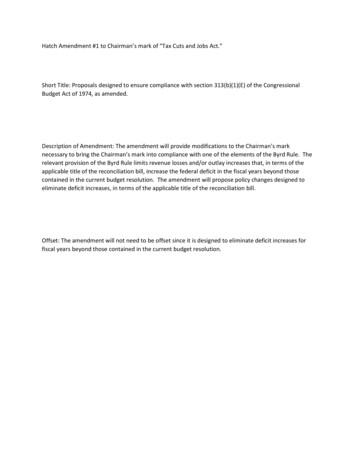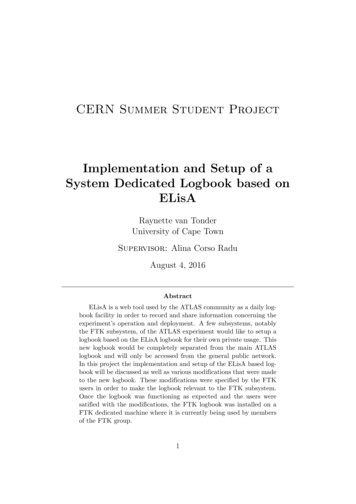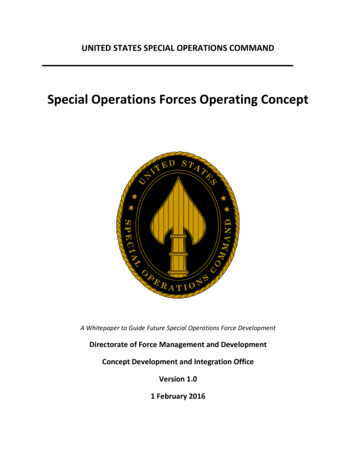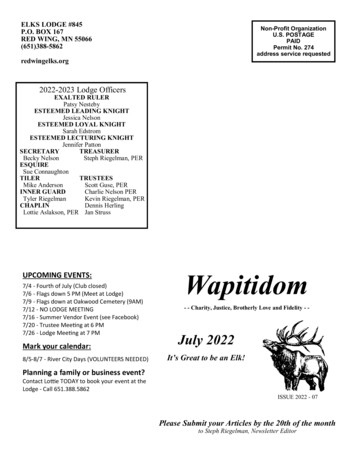
Transcription
Hatch Amendment #1 to Chairman’s mark of “Tax Cuts and Jobs Act.”Short Title: Proposals designed to ensure compliance with section 313(b)(1)(E) of the CongressionalBudget Act of 1974, as amended.Description of Amendment: The amendment will provide modifications to the Chairman’s marknecessary to bring the Chairman’s mark into compliance with one of the elements of the Byrd Rule. Therelevant provision of the Byrd Rule limits revenue losses and/or outlay increases that, in terms of theapplicable title of the reconciliation bill, increase the federal deficit in the fiscal years beyond thosecontained in the current budget resolution. The amendment will propose policy changes designed toeliminate deficit increases, in terms of the applicable title of the reconciliation bill.Offset: The amendment will not need to be offset since it is designed to eliminate deficit increases forfiscal years beyond those contained in the current budget resolution.
Hatch Amendment #2 to Chairman’s mark of “Tax Cuts and Jobs Act.”Cosponsors:Short Title: An amendment to the catch up contribution rules for section 401(k), 403(b) and 457)(b)retirement savings plans.Description of Amendment: This amendment would require all catch up contributions to section 401(k),403(b) and 457(b) retirement savings plans to be Roth only, and increase the 6,000 catch up contributionannual limit applicable to such plans to 9,000.Offset: This amendment is expected to raise revenue in the 10-year budget window.
Hatch Amendment #3 to Chairman’s mark of “Tax Cuts and Jobs Act.”Cosponsors:Short Title: An amendment to certain rules relating to Individual Retirement Accounts (IRAs).Description of Amendment: An amendment to repeal of special rule permitting recharacterization ofRoth IRA contributions as traditional IRA contributions.Offset: This amendment is expected to raise revenue in the 10-year budget window.
Hatch Amendment #4 to The Tax Cuts and Jobs ActCosponsors:Short Title: An amendment to section 170 of the Internal Revenue Code.Description of Amendment: A charitable deduction would be allowed for certain qualified tuition andrelated expenses relating to qualified religious instruction, as per the attached draft legislativelanguage.Offset: Approval of this amendment will be contingent on providing an appropriate offset.
115TH CONGRESS1ST SESSIONS.To amend the Internal Revenue Code of 1986 to allow a charitable deduction for certain tuitionpayments with respect to qualified religious instructionIN THE SENATE OF THE UNITED STATESOctober , 2017Mr. introduced the following bill; which was read twice and referred to theCommittee on FinanceA BILLTo amend the Internal Revenue Code of 1986 to allow a charitable deduction for certain tuitionpayments with respect to qualified religious instructionBe it enacted by the Senate and House of Representatives of the United States of America inCongress assembled,SECTION 1. SHORT TITLE.This Act may be cited as [the ‘‘ Act of 2017’’].SECTION 2. DEDUCTION FOR TUITION PAYMENTS FOR QUALIFIED RELIGIOUS INSTRUCTION
(a) DEDUCTION FOR CERTAIN PORTION OF TUITION PAYMENTS – Section 170 of such code is amendedby renumbering subsection (p) as subsection (q), and adding the following language as a new subsection(p):“(p) Treatment of certain tuition payments paid for qualified religious instruction.(1) In general. For purposes of this section, 25 percent of any amount described in paragraph (2)shall be treated as a charitable contribution.(2) Amount described. For purposes of paragraph (1), an amount is described in this paragraphif—(A) such amount is for payment of qualified tuition and related expenses as defined insection 25A(f)(1), except that such payment is made to a primary or secondary educationalorganization described in subparagraph (b)(1)(A)(ii) rather than an “eligible educationalinstitution,”(B) such organization certifies that 30 percent of the instruction it provides each academicyear consists of qualified religious instruction, and(C) such organization has provided the taxpayer a statement which contains theinformation required by section 6050T.For this purpose, qualified religious instruction shall mean academic instruction or trainingregarding a particular religion (including tenets, doctrines, beliefs, rituals, customs, and rites) ofa type not generally offered in public school curricula, which is provided by a teacher or otherinstructor who is certified as having had significant post-secondary religious studies.”(3) No double benefit. No deduction shall be allowed under this subsection (p) for the amountof any expense for which a deduction, credit or exclusion is allowed to the taxpayer under anyother provision of this chapter.(4) Regulations. The Secretary shall prescribe such regulations as may be necessary orappropriate to carry out the provisions of this subsection.
(b) INFORMATION RETURNS – A new section 6050T shall be added to such Code to read as follows:“Sec. 6050T. Returns relating to tuition for qualified religious education(a) In general. Any educational institution described in section 170(p)(2)(A) that meets therequirements of section 170(p)(2)(B) shall make a return with respect to an individual fromwhom it receives tuition payments and related expenses in such manner and at such time as theSecretary may by regulations prescribe that contains:(1) the name, address, and TIN of the individual for whom tuition payments and relatedexpenses described in subsection (a) are received,(2) the net amount of payments for qualified tuition and related expenses received with respectto the individual described in paragraph (1) during the calendar year,(3) a certification that the institution meets the requirements of section 170(p)(2)(B), and(4) such other information as the Secretary may prescribe.(b) Statements to be furnished to individuals with respect to whom information is required.Every person required to make a return under subsection (a) shall furnish to each individualwhose name is required to be set forth in such return under subparagraph (a) (1) a writtenstatement showing—(1) the name, address, and phone number of the information contact of the person required tomake such return, and(2) the information described in paragraph(a).The written statement required under the preceding sentence shall be furnished on or beforeJanuary 31 of the year following the calendar year for which the return under subsection (a) wasrequired to be made.
(c) Definition. For purposes of this section, “qualified tuition and related expenses” has themeaning given such term by section 170(p)(2)(A).(d) Regulations. The Secretary shall prescribe such regulations as may be necessary orappropriate to carry out the provisions of this section. No penalties shall be imposed under partII of subchapter B of chapter 68 with respect to any return or statement required under thissection until such time as such regulations are issued.”(c) CONFORMING AMENDMENT -- Section 170(f)(8)(A) of the Internal Revenue Code of 1986 is amendedto add the following sentence at the end thereof:“The previous sentence shall not apply to any qualified religious instruction meeting the requirements ofsection 170(p)(2)(B) and (C).”SECTION 3. EFFECTIVE DATE –(a) The amendments made by section 2 of this bill shall apply to taxable years beginning after December31, 2017.(b) Nothing contained in the amendments made by this bill shall create any inference regarding the taxtreatment of any other payment for religious education or training made before, on, or after theeffective date.
Hatch Amendment #5 to Chairman’s mark of “Tax Cuts and Jobs Act.”Short Title: Retirement and income tax improvements related to volunteer emergency firstresponders.Description of amendment: This amendment increases the limit on annual contributions tolength of service award programs consistent with the provisions of S. 1239, the LOSAP CAPAct, and exempts nominal incentives that volunteer firefighters and EMS personnel receive as areward for their service from being subject to federal income tax and reporting consistent withthe provisions of S. 1238, the Volunteer Responder Incentive Protection Act of 2017.Offset: To be provided.
Hatch Amendment #6 to Chairman’s mark of “Tax Cuts and Jobs Act.”Short Title: 12.5% Dividends Paid Deduction for Five YearsDescription of Amendment: This provision would allow corporations a deductionequal to 12.5% of the amount of dividends that they pay. This would betemporary for five years.Background: Under current law, the income of corporations is generally taxedtwice -- Once at the corporate level, and then again at the shareholder level whenthe earnings are distributed as a dividend.Given that corporations generally deduct interest, this has created a bias in thetax law for corporations to finance via debt rather than via equity. By allowing apartial dividends paid deduction, this would partially correct for thisphenomenon.Furthermore, current law creates distortions in the selection of business entity.This would reduce such distortions.Generally, and ideally, business income should be taxed once and only once. Thisamendment would be a step in that direction.COST: The estimated cost of the amendment will be supplied by the Joint TaxCommittee.OFFSET: To be provided based on Joint Tax Committee score.
Hatch Amendment #7 to Chairman’s mark of “Tax Cuts and Jobs Act.”Treatment of Sourcing Rules for US TerritoriesBACKGROUND:Code Section 937 provides that income effectively connected with the conduct of a trade orbusiness within the United States shall not be treated as income effectively connected with theconduct of a trade or business within any possession (the U.S. Territories). This rule appliesregardless of where the office or fixed place of business connected to such trade or business islocated.Code Section 865 provides favorable treatment on income sourced within Guam, AmericaSamoa, Northern Mariana Islands, and Puerto Rico with respect to personal property sales. Therule that an income tax equal to at least 10 percent of the income from personal property salesmust be paid to the foreign country does not apply to Guam, America Samoa, Northern MarianaIslands, and Puerto Rico. Clarification that the US Virgin Islands (USVI) is afforded the sametreatment is required to ensure parity among the territories.AMENDMENTThe amendment would modify the US limitation on effectively connected income to allowconsideration of where the office or fixed place of business connected to such trade or business islocated. Under the amendment, income effectively connected with the conduct of a trade orbusiness within a possession would be treated as income effectively connected with thatpossession, to the extent such income is attributable to an office or fixed place of business withinthat possession. The amendment would not change the general sourcing rules.The treatment of the sourcing rules for personal property sales within the USVI would clarifythat the treatment afforded to the other Territories is applicable to the USVI. Under theamendment, personal property sales in the USVI would be treated the same as personal propertysales in other Territories.COST: The estimated cost of the amendment will be supplied by the Joint Tax Committee.OFFSET: To be provided based on Joint Tax Committee score.
Hatch Amendment #8 to Chairman’s mark of “Tax Cuts and Jobs Act.”Treatment of Sourcing Rules for US TerritoriesBACKGROUND:Code Section 937 provides that income effectively connected with the conduct of a trade orbusiness within the United States shall not be treated as income effectively connected with theconduct of a trade or business within any possession (the U.S. Territories). This rule appliesregardless of where the office or fixed place of business connected to such trade or business islocated.Code Section 865 provides favorable treatment on income sourced within Guam, AmericaSamoa, Northern Mariana Islands, and Puerto Rico with respect to personal property sales. Therule that an income tax equal to at least 10 percent of the income from personal property salesmust be paid to the foreign country does not apply to Guam, America Samoa, Northern MarianaIslands, and Puerto Rico. Clarification that the US Virgin Islands (USVI) is afforded the sametreatment is required to ensure parity among the territories.AMENDMENTThe amendment would modify the US limitation on effectively connected income to allowconsideration of where the office or fixed place of business connected to such trade or business islocated. Under the amendment, income effectively connected with the conduct of a trade orbusiness within a possession would be treated as income effectively connected with thatpossession, to the extent such income is attributable to an office or fixed place of business withinthat possession. The amendment would not change the general sourcing rules.The treatment of the sourcing rules for personal property sales within the USVI would clarifythat the treatment afforded to the other Territories is applicable to the USVI. Under theamendment, personal property sales in the USVI would be treated the same as personal propertysales in other Territories.COST: The estimated cost of the amendment will be supplied by the Joint Tax Committee.OFFSET: To be provided based on Joint Tax Committee score.
Hatch Amendment #9 to Chairman’s mark of “Tax Cuts and Jobs Act.”Short Title: Permanent Accelerated Depreciation on Indian ReservationsDescription of Amendment: Would make permanent the provision for Accelerated depreciation forbusiness property on an Indian reservation (sec. 168(j)).Offset: To be Provided
Hatch Amendment #10 to Chairman’s mark of “Tax Cuts and Jobs Act.”Short Title: To amend the alternative depreciation system (ADS) recovery period for residential rentalpropertyDescription of Amendment: The amendment would change the ADS recovery period for residentialrental property from 40 years to 30 years.Offset: To be Provided
Hatch Amendment #11 to the Tax Cuts and Jobs ActShort Title: Biomass Thermal Utilization Act of 2017Description of Amendment: This amendment adds high efficiency biomass thermal technologies to thelist of renewable energy technologies that benefit from investment tax credits under section 25D andSection 48 of the tax code consistent with the provisions of S. 1480, the Biomass Thermal Utilization Act.Offset: To be Provided
Hatch Amendment #12 to the Tax Cuts and Jobs ActShort Title: S.1663, CO2 Regulatory Certainty Act, as introduced by Senator HoevenDescription of Amendment: To amend the Internal Revenue Code of 1986 to enhance the requirementsfor secure geological storage of carbon dioxide for purposes of the carbon dioxide sequestration credit.Offset: To be Provided
Hatch Amendment #13 to the Tax Cuts and Jobs ActShort Title: S. 1054, the Dynamic Glass Act, as introduced by Senator Wicker.Description of Amendment: To amend the definition of energy property under Section 48 of the InternalRevenue Code of 1986, allowing an innovative technology known as electrochromatic glass to receivethe business energy investment tax credit.Offset: To be Provided
Hatch Amendment #14 to the Tax Cuts and Jobs ActShort Title: S.1716, Strong Families Act of 2017, as introduced by Senator Fischer.Description of Amendment: To amend the Internal Revenue Code of 1986 to provide a credit toemployers who provide paid family and medical leave, and for other purposes.Offset: To be Provided
Hatch Amendment #15 to the Tax Cuts and Jobs ActShort Title S. 1698, Settlement Trust Improvement Act of 2017, as introduced by Senator Murkowski.Description of Amendment: To amend the Internal Revenue Code of 1986 to clarify the treatment ofcontributions to Alaska Native Settlement Trusts, and for other purposes.Offset: To be Provided
Hatch Amendment # 16 to the Tax Cuts and Jobs ActShort Title: To provide for modifications to the limitation on deduction for interestDescription of Amendment: The amendment would make clarifications and modifications with respectto the limitation on the deduction for interest, including the application of the rule to certainpartnerships.Offset: To be Provided
Hatch Amendment #17 to the Tax Cuts and Jobs ActShort Title: Selected Provisions from S. 548, the Affordable Housing Credit Improvement Act of 2017Description of Amendment: This amendment is to adopt the provisions of S. 548 that do not have arevenue score, but will make improvements to the Low Income Housing Tax Credit Program.Offset: To be Provided (shouldn’t be necessary)
Hatch Amendment #18 to the Tax Cuts and Jobs ActShort Title: Master Limited Partnerships Parity Act. S.2005, as introduced by Senator Coons, SenatorMoran and others.The provision would expand the eligibility requirements for master limited partnerships within7704(d)(1) of the Internal Revenue Code of 1986 to include a range of new energy resources, such aselectric generation from renewable sources, biofuels, energy storage, and energy efficiency, amongothers.Offset: To be Provided
Hatch Amendment #19 to the Tax Cuts and Jobs ActShort Title: Modifications to the Refined Coal Tax CreditDescription of Amendment: Provide existing coal facilities an additional 10-year window to claim the refined coal tax credit.This affects facilities originally placed in service from 2005 to 2009. Create a new placed-in-service opportunity for new refined coal facilities (from December 31,2017 to January 1, 2021), which could be claimed over a 10-year period.Offset: To be Provided
Hatch Amendment #20 to the Tax Cuts and Jobs ActShort Title: S. 1935, Tribal Tax and Investment Reform Act of 2017Description of Amendment: Amendment would specify the treatment of Indian Tribes as States withRespect to Bond Issuance, modify the treatment of pension and employee benefit plans maintained byTribal Government, modify the treatment of Tribal Foundations and charities, improve the effectivenessof Tribal child support enforcement agencies, and recognize Indian Tribal governments for purposes ofdetermining under the adoption tax credit whether a child has special needs.Offset: To be Provided
Hatch Amendment #21 to the Tax Cuts and Jobs ActShort Title: S. 2012, Tribal Economic Assistance Act of 2017.Description of Amendment: Amendment would repeal the essential government function test for IndianTribal governments with respect to issuance of tax-exempt bonds, make permanent accelerateddepreciation business property on an Indian reservation and the Indian Employment Tax Credit, modifythe New Markets Tax Credit Program, and create Tribal School Construction Bonding Accounts.Offset: To be Provided
Hatch Amendment # 22 to the Tax Cuts and Jobs ActShort Title: To provide for the treatment of domestic partnerships and partners in the new internationaltax systemDescription of Amendment: The amendment would make clarifications with respect to domesticpartnerships and partners to several of the international tax provisions of the bill, including theparticipation exemption, the repatriation transition tax, and the current year inclusion of GILTI by U.S.shareholders.Offset: To be Provided
Hatch Amendment #23 to the Tax Cuts and Jobs ActShort Title: Proposal to specify the scope of tax-exempt activities of Alaska Community DevelopmentQuota program entities.Description of Amendment: The Western Alaska Community Development Quota program allocates apercentage of certain Bering Sea and Aleutian Islands fisheries quotas to eligible communities. Theprovision would clarify the tax liability of CDQ entities and reaffirm their nonprofit status.Offset: To be Provided
Hatch Amendment #24Increase of the Alternative Simplified Credit from 14% to 15%BACKGROUND:Under the section 41 Alternative Simplified Credit R&D Credit calculation, thecredit is 14% of such Qualified Research Expenses as exceed an ASC baseamount.AMENDMENTThis amendment would change the ASC percentage amount from 14% to 15%,effective for taxable years beginning after December 31, 2018.COST: The estimated cost of the amendment will be supplied by the Joint TaxCommittee.OFFSET: To be provided based on Joint Tax Committee score.
Hatch AMENDMENT #25 CORPORATE INTEGRATIONHatch Amendment regarding Corporate IntegrationShort Title: 12.5% Dividends Paid Deduction for Five YearsDescription of Amendment: This provision would allow corporations a deductionequal to 12.5% of the amount of dividends that they pay. This would betemporary for five years.Background: Under current law, the income of corporations is generally taxedtwice -- Once at the corporate level, and then again at the shareholder level whenthe earnings are distributed as a dividend.Given that corporations generally deduct interest, this has created a bias in thetax law for corporations to finance via debt rather than via equity. By allowing apartial dividends paid deduction, this would partially correct for thisphenomenon.Furthermore, current law creates distortions in the selection of business entity.This would reduce such distortions.Generally, and ideally, business income should be taxed once and only once. Thisamendment would be a step in that direction.COST: The estimated cost of the amendment will be supplied by the Joint TaxCommittee.OFFSET: To be provided based on Joint Tax Committee score.
Hatch Amendment re R&D Credit #26Increase of the Alternative Simplified Credit from 14% to 15%BACKGROUND:Under the section 41 Alternative Simplified Credit R&D Credit calculation, thecredit is 14% of such Qualified Research Expenses as exceed an ASC baseamount.AMENDMENTThis amendment would change the ASC percentage amount from 14% to 15%,effective for taxable years beginning after December 31, 2018.COST: The estimated cost of the amendment will be supplied by the Joint TaxCommittee.OFFSET: To be provided based on Joint Tax Committee score.
Hatch Amendment #27 to Chairman’s mark of “Tax Cuts and Jobs Act.”Short Title: Proposal to modify income thresholds for Head of Household filing statusDescription of Amendment: The amendment will provide modifications to the Chairman’s mark toredetermine the thresholds for head of household filings status.Offset: To be provided based on Joint Tax Committee score.
Grassley Amendment #1 to the Tax Cuts and Jobs ActCosponsor(s):Short Title: To unify the tax treatment of whistleblower awardsDescription of Amendment: Under current law, an above-the-line deduction is provided for certain legalfees in connection with certain whistleblower awards. IRC section 62(a)(20) provides for the deductibilityof attorney fees and court costs incurred by a taxpayer in a claim under the False Claims Act (subchapterIII of chapter 37 of Title 31 of the United States Code). Additionally, IRC section 62(a) (21) provides acomparable deduction for legal costs associated with awards provided under IRC Section 7623. Thisamendment would extend the same deduction provided for False Claims Act awards and IRSwhistleblower program awards to awards paid under State False Claims Acts, the SEC whistleblowerprogram (Sections 78u-6 and 78u-7 of title 15 of the United States Code), and the Commodity FuturesTrading Commission whistleblower program (Section 26 of title 7 of the United States Code).Offset: To be provided
Grassley Amendment #2 to the Tax Cuts and Jobs ActCosponsor(s):Short Title: To improve the IRS Whistleblower ProgramDescription of Amendment: Under current law, IRC Section 7623 provides for awards to be paid towhistleblowers who provide information that leads to collection of taxes that may otherwise go unpaid.This amendment seeks to clarify the basis for such awards by providing a definition for “proceeds”. Forpurposes of IRC section 7623, proceeds would be defined to include:“(A) taxes, penalties, interest additions to tax, and additional amounts provided under theinternal revenue laws, and (B) any proceeds arising from laws for which the Internal RevenueService is authorized to administer, enforce, or investigate including (i) criminal fines an civilforfeitures, and, (ii) violations of reporting requirements.”Moreover, it would amend the disputed amount threshold in 7623(b)(5)(B) so that the 2 millionthreshold is based on the “proceeds” (as defined above) in dispute.Offset: To be provided
Grassley Amendment #3 to the Tax Cuts and Jobs ActCosponsor(s): Senator ThuneShort Title: To increase the time period in which taxpayers may seek to have proceeds from the saleof wrongfully levied property returned to them.Description of Amendment: The IRS is authorized to levy on property to satisfy a tax debt in certaininstances. While the IRS is authorized to return property at any time, it is only authorized to return themonetary proceeds from a sale for up to nine months from the date of the levy. Similarly, if a thirdparty believes the property levied or seized belongs to him/her and not the person against whom thetax is assessed, the third party generally only has nine months from the time of the levy to bring anadministrative wrongful-levy action to seek the return of monetary proceeds. In many cases the ninemonth period is insufficient for individuals and third parties to discover a wrongful or mistaken levyand seek to remedy it. Consistent with section 202 of S. 1793, the Taxpayer Bill of RightsEnhancement Act of 2017, this amendment would extend from nine months to two years the timeperiod that individuals and third parties have to seek the return of proceeds on the sale of wrongfullylevied property.Offset: To be provided
Grassley Amendment #4 to the Tax Cuts and Jobs ActCosponsor(s): Senator ThuneShort Title: Individuals held harmless on improper levy on retirement plans.Description of Amendment: Under present law, if the IRS improperly levies on an IRA or anemployer sponsored plan, the individual owning the retirement account may not be made whole, evenif the IRS returns the amount levied, with interest, because the individual may lose the opportunity tohave those funds accumulate on a tax-favored basis until retirement. Consistent with section 302 of s.1793, the Taxpayer Bill of Rights Enhancement Act of 2017, this amendment (1) holds the taxpayerharmless by permitting an individual to recontribute wrongfully levied amounts to an IRA or employersponsored plan without regard to contribution limits, (2) abates any tax that may have been appliedwith respect to the distribution made as a result of the wrongful levy if recontributed to the IRA oremployer sponsored plan, (3) and expands the instances where the IRS must pay interest on amountsreturned as a result of a wrongful levy.Offset: To be provided
Grassley Amendment #5 to the Tax Cuts and Jobs Act of 2017Cosponsor(s): Senator ThuneShort Title: Increase in and expansion of individual estimated tax exception.Description of Amendment: Under current law, a penalty is imposed on a taxpayer for theunderpayment of estimated tax if tax owed at end of year is 1,000 or more. The threshold was lastincreased in 1998 from 500 to 1,000. Consistent with Section 304 of S. 1793, the Taxpayer Bill ofRights Enhancement Act, this amendment increases the threshold amount to 2,000. Moreover, theapplication of this current safe harbor only provides credit for withholding from wages. Consistentwith Section 304 of S. 1793, the amendment also expands the application of the safe harbor to providetaxpayers with credit for estimated tax payments provided an estimated tax payment is made in anyquarter in which an estimated tax payment is required and the payment is at least 90 percent of the fullpayment due.Offset: To be provided
Grassley Amendment #6 to the Tax Cuts and Jobs Act of 2017Cosponsor(s): Senator ThuneShort Title: Modifications to computation of individual estimated tax.Description of Amendment: Under current law, calculating interest on underpayments can becomplicated and confusing, often requiring multiple calculations that require varying interest ratesacross payment periods. Consistent with Section 305 of S. 1793, the Taxpayer Bill of RightsEnhancement Act, this amendment simplifies the underpayment calculation by (1) applying only oneinterest rate per estimated tax underpayment period, (2) providing that underpayment balances arecumulative, and (3) allowing for a 365-day year for all estimated tax interest calculations.Offset: To be provided
Grassley Amendment #7 to the Tax Cuts and Jobs ActCosponsor(s): Senator ThuneShort Title: To Increase small corporation threshold for estimated tax paymentsDescription of Amendment: Under current law, companies with taxable income under 1 millionmay base their estimated tax payments on the previous year’s tax while corporations with taxableincome of 1 million or more may not. The threshold has been 1 million since 1996. Consistent withsection 307 of S.1793, the Taxpayer Bill of Rights Enhancement Act of 2017, this amendmentincreases the threshold to 1.5 million to increase the number of small businesses able to use asimplified method for determining estimated tax payments.Offset: To be provided
Grassley Amendment #8 to the Tax Cuts and Jobs ActCosponsor(s): Senator ThuneShort Title: To waive the user fee for installment agreements using automated withdrawals.Description of Amendment: Taxpayers who are unable to pay their taxes in full may be eligible toenter into an agreement with the IRS to pay their tax bill through installment payments. However,taxpayers who enter into installment agreements are generally charged a user fee by the IRS in additionto interest and penalties that may continue to accrue during the payment period. To encourage the useof automated installment payments and to increase the efficiency and timely payment of taxes, thisamendment (consistent with section 301 of S.1793, the Taxpayer Bill of
Hatch Amendment #2 to hairman's mark of "Tax uts and Jobs Act." Cosponsors: Short Title: An amendment to the catch up contribution rules for section 401(k), 403(b) and 457)(b) retirement savings plans. Description of Amendment: This amendment would require all catch up contributions to section 401(k), 403(b) and 457(b) retirement savings plans to be Roth only, and increase the 6,000 .










